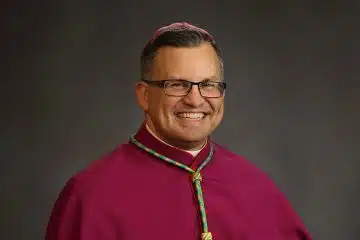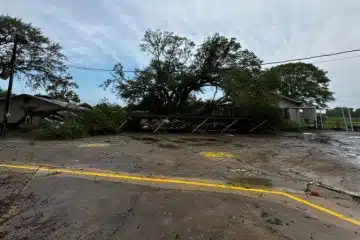Central Americans want to stay home; development programs help that happen

IMAGE: CNS photo/Julian Spath, Catholic Relief Services
By Dennis Sadowski
WASHINGTON (CNS) — Vanessa Urbina understands how young people in Central America, not seeing an opportunity for work or a good education, could be attracted to make the dangerous trip north in the hope of a better future in the United States.
"Some live in neighborhoods dominated with guns, violence and drug trafficking," she said. "It discourages them from wanting to go to school. It closes the door for them."
As coordinator of Fe y Alegria (Faith and Joy), a training and support program for teenagers and young adults in El Progreso, Honduras, Urbina is working to overcome such negative influences and engender a belief that emigration is not the only option.
The operation partners with Catholic Relief Service’s YouthBuild program, which helps unemployed and out-of-school young people, ages 16 to 24, return to school, find work or start their own business.
Fe y Alegria enrolls 400 to 600 young people in each session, said Urbina, 37, who has been coordinator for more than six years after completing her master’s degree in Taiwan.
The program’s goal is to keep people in local communities so that they can help build a stronger economy in one of the poorest nations in the Western Hemisphere. Students learn various skills in automotive and motorcycle repair, graphic arts, website development, baking and agriculture.
About 20 similar YouthBuild programs exist in El Salvador, Guatemala, Honduras and Nicaragua, said Rick Jones, senior technical adviser in Latin American and the Caribbean for CRS, the U.S. bishops’ overseas relief and development agency.
The program is adapted from a model of the same name developed in the United States in the 1970s. Coursework is based on demands of the local labor markets.
Beyond skill development, the programs help students develop interpersonal and life skills, including self-esteem, conflict resolution and teamwork.
Despite Fe y Alegria’s efforts, some students are enticed to leave because their families decide to head north, Urbina told Catholic News Service. Last winter about 20 students — of 467 enrollees — joined caravans headed to the U.S., their fate unknown, she said.
The training lasts up to two years and focuses on developing the skills most in need locally. After completion, Urbina and her staff connect students with local companies seeking to hire people at reasonable wages. Some students even open their own business.
"There are many possibilities because they get a job. They don’t have to leave. They have income," Urbina said.
"You can notice the difference in the young people from when they start and then when they finish," she continued. "They are more mature about their future. They want to be a different person. Some of them only know the violence in the towns and when they’re in the program, they change their mind. They think they have a better future. If they have the right attitude, that can be possible."
Jones said about 80% of YouthBuild graduates find work. He credited the high success rate to not just skill development but also to providing the emotional support young people need to cope in the challenging environment in which they live.
Most young people want to stay in Honduras with their families, he explained.
"They’d much rather stay here because they’re home," he told CNS. "There’s a saying: ‘Nobody leaves home unless home is in the mouth of a shark.’ When you’re threatened, people don’t have any other choice (but to leave)."
YouthBuild also has been developing an agricultural program for young people. Trainers have encouraged young people to develop new products beyond the traditional crops.
Jones identified beekeeping as an area of growing interest. There’s also an emerging specialty dairy market in which graduates are producing yogurt, cheeses and other in-demand products.
"A lot of young people are willing to do agriculture," Jones said. "This idea that they don’t want to do agriculture is a myth. What they don’t want to do is be tied to corn and beans. So what we’re trying to do is find the crops that are in demand and finding more markets for what’s being grown."
YouthBuild also is training young people to monitor the environment, a need that is growing in a region that is seeing changing weather patterns that has disrupted traditional planting and harvesting cycles.
"We just reactivated a rural high school degree in agriculture," he explained. "Right now education doesn’t train people to stay on the land in the rural areas. We’ve got to get people reconnected and give young people exciting options where they use technology to create new opportunities and not feel the only action they have is to leave."
Elsewhere in Central America, largely in the region’s so-called dry corridor that stretches across 10 of Guatemala’s 22 departments and much of Central America, efforts are underway to help farmers better respond to a changing climate so they are not forced to migrate.
Dan McQuillan, technical adviser for agriculture for CRS in Latin America, said the U.S. bishops’ relief and development agency is implementing Water-Smart Agriculture, or Agua y Suelo para law Agricultura, known in Spanish as ASA.
He said the program has moved from watershed management for household consumption to managing limited water resources, especially among subsistence farmers. The evolution emerged because of less predictable rain patterns caused by climate change.
The program also is working on a broader scale, educating urban and rural dwellers about water management.
The U.N. Food and Agriculture Organization and the World Food Program warned in an April report that prolonged droughts and brief heavy rains destroyed more than half the corn and bean crops of subsistence farmers, leading to declining production and more food insecurity. About 1.4 million people are facing food shortages, the agencies said.
In years past, farmers could anticipate when rain would come and prepare their fields appropriately. When necessary, they would borrow money for planting and then pay off the loan when they sold part of their crop beyond what they needed to feed their family.
With erratic rain patterns, however, farmers can misjudge when to plant and lose a substantial portion of their crop if they plant too early or too late. With reduced yields a family could face a greater risk of hunger or a loss of income. Further, common illnesses such as infectious disease, diarrhea and pneumonia compound hunger. Such a situation can fuel emigration to the U.S.
Under ASA, McQuillan said, farmers are learning about crop rotation, cover crops and other practices that hold water in the soil and limit the impact of inconsistent rainfall.
McQuillan said the practices farmers are implementing seem to encourage farmers to "stick it out." "One coffee farmer told us that he was thinking about leaving, and the last three years the yield has increased so he’s working at it," McQuillan said.
ASA also has begun discussing how to more effectively use satellite data and other technology to the benefit of farmers. For now, McQuillan said, local efforts will concentrate on tracking rain and weather patterns to aid in the hope finding the optimal time for planting.
– – –
Follow Sadowski on Twitter: @DennisSadowski
– – –
Copyright © 2019 Catholic News Service/U.S. Conference of Catholic Bishops. www.catholicnews.com. All rights reserved. Republishing or redistributing of CNS content, including by framing or similar means without prior permission, is prohibited. You may link to stories on our public site. This copy is for your personal, non-commercial use only. To request permission for republishing or redistributing of CNS content, please contact permissions at [email protected].













